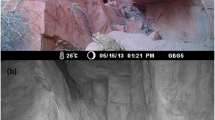Abstract
Habituation is used in most field research with primates to minimize observer effects on their behavior. Despite its importance, there is little published on the methods used to habituate different taxa of primates or how these methods vary in different habitat types. We assessed changes in behavior and space use of two groups of Leontocebus lagonotus in the Ecuadorian Amazon in order to document this process. Although the subjects had not been studied before, visitors and researchers were more frequently in the home range of Group 1 than of Group 2. We followed both groups for 2 months, collecting behavioral data through scan sampling and recording the use of space (ground, understory, subcanopy, and canopy) and the routes along which we followed the groups. We then divided our data into two equivalent stages, randomized the data for each stage and looked for significant differences using Wilcoxon tests. Our results show a significant decrease in submissive behaviors toward the observer for both groups and a significant increase in resting and foraging for Group 1. In addition, Group 2 used the subcanopy significantly less and the understory more during the second stage. The routes the animals used were significantly longer in the second stage for Group 1, but not for Group 2. We conclude that our methodology is adequate to advance in the habituation of L. lagonotus in less than 2 months and that a group will habituate more quickly if it has had some previous neutral exposure to humans.


Similar content being viewed by others
References
Aguiar LM, Moro-Rios RF (2009) The direct observational method and possibilities for neotropical carnivores: an invitation for the rescue of a classical method spread over the primatology. Zoologia (Curitiba) 26:587–593. https://doi.org/10.1590/S1984-46702009000400001
Altmann J (1974) Observational study of behavior: sampling methods. Behaviour 49:227–266. https://doi.org/10.1163/156853974X00534
Andrews JR, Birkinshaw CR (1998) A comparison between the daytime and night time diet, activity and feeding height of the black lemur, Eulemur macaco (Primates: Lemuridae), in Lokobe Forest, Madagascar. Folia Primatol 69:175–182. https://doi.org/10.1159/000052711
Aquino R, Encarnación F (1994) Primates of Peru/Los primates del Peru. Primate Rep 40:1–127
Aquino R, Charpentier E, García G (2014) Diversidad y abundancia de primates en hábitats del área de influencia de la carretera Iquitos-Nauta, amazonía peruana. Cienc Amaz 4:3–12
Bertolani P, Boesch C (2008) Habituation of wild chimpanzees (Pan troglodytes) of the south group at Taï Forest, Côte d’Ivoire: empirical measure of progress. Folia Primatol 79:162–171. https://doi.org/10.1159/000111720
Bianchi RDC, Mendes SL (2007) Ocelot (Leopardus pardalis) predation on primates in Caratinga Biological Station, southeast Brazil. Am J Primatol 69:1173–1178. https://doi.org/10.1002/ajp.20415
Blom A, Cipolletta C, Brunsting AMH, Prins HHT (2004) Behavioral responses of gorillas to habituation in the Dzanga-Ndoki National Park, Central African Republic. Int J Primatol 25:179–196. https://doi.org/10.1023/B:IJOP.0000014649.15973.3a
Carpenter CR (1934) A field study of the behavior and social relations of howling monkeys. Psychol Monogr 10:168
Connor RC, Smolker RS (1985) Habituated dolphins (Tursiops sp.) in Western Australia. J Mammal 66:398–400. https://doi.org/10.2307/1381260
De la Torre S (2017) Distribution and demography of Leontocebus spp. in Amazonian Ecuador, are they influenced by human activities? BioBrasil 7:133–144
de Oliveira CR, Ruiz-Miranda CR, Kleiman DG, Beck BB (2003) Play behavior in juvenile golden lion tamarins (Callitrichidae: Primates): organization in relation to costs. Ethology 109:593–612. https://doi.org/10.1046/j.1439-0310.2003.00901.x
Devries PJ, Murray D, Lande R (1997) Species diversity in vertical, horizontal, and temporal dimensions of a fruit-feeding butterfly community in an Ecuadorian rainforest. Biol J Linn Soc 62:343–364. https://doi.org/10.1111/j.1095-8312.1997.tb01630.x
Doran-Sheehy DM, Derby AM, Greer D, Mongo P (2007) Habituation of western gorillas: the process and factors that influence it. Am J Primatol 69:1354–1369. https://doi.org/10.1002/ajp.20442
Ellenberg U, Mattern T, Seddon PJ (2009) Habituation potential of yellow-eyed penguins depends on sex, character and previous experience with humans. Anim Behav 77:289–296. https://doi.org/10.1016/J.ANBEHAV.2008.09.021
Goldsmith ML (2005) Habituating primates for field study: ethical considerations for African great apes. In: Turner TR (ed) Biological anthropology and ethics: from repatriation to genetic identity. State University of New York Press, New York, pp 49–62
Goodall J (1986) The chimpanzees of Gombe: patterns of behavior. Belknap Press of Harvard University Press, Cambridge, Massachusetts
Hofer H, East ML (2008) Siblicide in Serengeti spotted hyenas: a long-term study of maternal input and cub survival. Behav Ecol Sociobiol 62:341–351. https://doi.org/10.1007/s00265-007-0421-3
Jack KM, Lenz BB, Healan E et al (2008) The effects of observer presence on the behavior of Cebus capucinus in Costa Rica. Am J Primatol 70:490–494. https://doi.org/10.1002/ajp.20512
Jatun Sacha Foundation (2018) Jatun Sacha Biological Reserve. https://www.jatunsacha.org/jatun-sacha-biological-reserve/. (Accessed 28 May 2018)
Kobayashi S, Langguth A (1999) A new species of titi monkey, Callicebus thomas, from north-eastern Brazil (Primates, Cebidae). Rev Bras Zool 16:531–551. https://doi.org/10.1590/s0101-81751999000200018
Marsh CW (1981) Time budget of Tana river red colobus. Folia Primatol 35:30–50. https://doi.org/10.1159/000155964
Mikula P, Šaffa G, Nelson E, Tryjanowski P (2018) Risk perception of vervet monkeys Chlorocebus pygerythrus to humans in urban and rural environments. Behav Proc 147:21–27. https://doi.org/10.1016/J.BEPROC.2017.12.011
Murray DL (2000) A survey of the butterfly fauna of Jatun Sacha, Ecuador (Lepidoptera: hesperioidea and papilionoidea). J Res Lepid 35:42–60
Narat V, Pennec F, Simmen B et al (2015) Bonobo habituation in a forest–savanna mosaic habitat: influence of ape species, habitat type, and sociocultural context. Primates 56:339–349. https://doi.org/10.1007/s10329-015-0476-0
Passamani M (1998) Activity budget of Geoffroy’s marmoset (Callithrix geoffroyi) in an Atlantic forest in southeastern Brazil. Am J Primatol 46:333–340. https://doi.org/10.1002/(SICI)1098-2345(1998)46:4%3c333::AID-AJP5%3e3.0.CO;2-7
Pearman PB, Velasco AM, López A (1995) Tropical amphibian monitoring: a comparison of methods for detecting inter-site variation in species’ composition. Herpetologica 51:325–337
Peres CA (1999) General guidelines for standardizing line-transect surveys of tropical forest primates. Neotrop Primates 7:11–16
Porter LM (2001) Social organization, reproduction and rearing strategies of Callimico goeldii: new clues from the wild. Folia Primatol 72:69–79. https://doi.org/10.1159/000049925
Porter LM, Garber PA (2010) Mycophagy and its influence on habitat use and ranging patterns in Callimico goeldii. Am J Phys Anthropol 142:468–475. https://doi.org/10.1002/ajpa.21259
Rasmussen DR (1979) Correlates of patterns of range use of a troop of yellow baboons (Papio cynocephalus). I. Sleeping sites, impregnable females, births, and male emigrations and immigrations. Anim Behav 27:1098–1112. https://doi.org/10.1016/0003-3472(79)90058-7
Rasmussen DR (1998) Changes in range use of Geoffroy’s tamarins (Saguinus geoffroyi) associated with habituation to observers. Folia Primatol 69:153–159. https://doi.org/10.1159/000021577
Rylands AB (1986) Ranging behaviour and habitat preference of a wild marmoset group, Callithrix humeralifer (Callitrichidae, Primates). J Zool 210:489–514. https://doi.org/10.1111/j.1469-7998.1986.tb03652.x
Rylands AB, Heymann EW, Lynch Alfaro J et al (2016) Taxonomic review of the New World tamarins (Primates: Callitrichidae). Zool J Linn Soc 177:1003–1028. https://doi.org/10.1111/zoj.12386
Souza-Alves JP, Ferrari SF (2010) Responses of wild titi monkeys, Callicebus coimbrai (Primates: Platyrrhini: Pitheciidae), to the habituation process. Zoologia (Curitiba) 27:861–866. https://doi.org/10.1590/S1984-46702010000600004
Sugiyama Y (2015) Influence of provisioning on primate behavior and primate studies. Mammalia 79:255–265. https://doi.org/10.1515/mammalia-2014-0028
Tutin CEG, Fernandez M (1991) Responses of wild chimpanzees and gorillas to the arrival of primatologists: behaviour observed during habituation. Primate responses to environmental change. Springer, Netherlands, Dordrecht, pp 187–197
Van der Hoek Y, Solas SÁ, Peñuela MC (2019) The palm Mauritia flexuosa, a keystone plant resource on multiple fronts. Biodivers Conserv 28:539–551. https://doi.org/10.1007/s10531-018-01686-4
Vigle GO (2008) The amphibians and reptiles of the Estación Biológica Jatun Sacha in the lowland rainforest of Amazonian Ecuador: a 20-year record. Breviora 514:1. https://doi.org/10.3099/0006-9698-514.1.1
Whittaker D, Knight RL (1998) Understanding wildlife responses to humans. Wildl Soc Bull 26:312–317
Williamson EA, Feistner ATC (2003) Habituating primates: processes, techniques, variables and ethics. In: Setchell JM, Curtis DJ (eds) Field and laboratory methods in primatology : a practical guide. Cambridge University Press, Cambridge, p 343
Wrangham RW (1974) Artificial feeding of chimpanzees and baboons in their natural habitat. Anim Behav 22:83–93. https://doi.org/10.1016/S0003-3472(74)80056-4
Acknowledgements
This work was supported by the Agencia Española de Cooperación Internacional para el Desarrollo (AECID), N/Ref./Expediente n. 2015/SPE/0000400126. We would like to thank the Fundació Universitat de Girona: Innovació i Formació and the Universidad Regional Amazónica Ikiam for the agreement that made possible our research in the Ecuadorian Amazon. We are also thankful to the staff of the Jatun Sacha Biological Station for allowing and facilitating our research in the reserve and for their kindness during our stay. We especially want to thank Alejandro Suárez (former director of the JSBS) for providing us with the documents from which we created the maps of the reserve and, above all, for his valuable support throughout the entire study. We would like to thank Dr. Stella de la Torre for sharing her useful knowledge about Leontocebus lagonotus. Finally, we are grateful to Dr. Eckhard W. Heymann and to two anonymous reviewers, whose interest and helpful comments greatly improved the quality of this article. We confirm that our research complies with the legal and ethical requirements for the study of wild primates in Ecuador. The authors declare no conflict of interest.
Author information
Authors and Affiliations
Contributions
All authors contributed significantly to the study. The design of the work was carried out by Sara ÁS and SV-A. Data collection was performed by SV-A and LS-S. Data analysis and interpretation was performed by SV-A and Sara ÁS. The first draft was written by SV-A and both Sara ÁS and LS-S contributed to its improvement with comments and work in the elaboration of the figures. All authors read and approved the final manuscript.
Corresponding author
Ethics declarations
Conflict of interest
The authors declare that they have no conflict of interest.
Additional information
Publisher's Note
Springer Nature remains neutral with regard to jurisdictional claims in published maps and institutional affiliations.
Appendix
Below is the link to the electronic supplementary material.
About this article
Cite this article
Vicente-Alonso, S., Sánchez-Sánchez, L. & Álvarez Solas, S. On the way to systematize habituation: a protocol to minimize the effects of observer presence on wild groups of Leontocebus lagonotus. Primates 62, 407–415 (2021). https://doi.org/10.1007/s10329-020-00877-4
Received:
Accepted:
Published:
Issue Date:
DOI: https://doi.org/10.1007/s10329-020-00877-4




